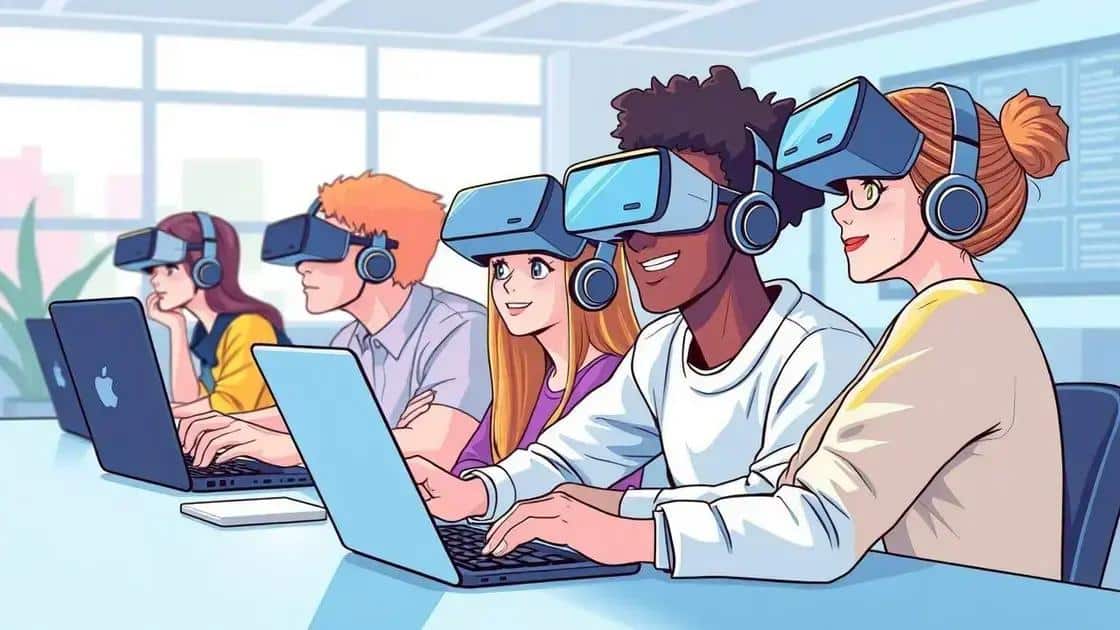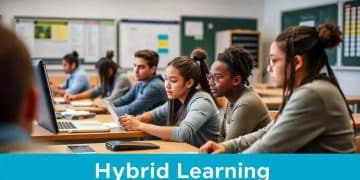Insights on remote learning platforms: what you need to know

Remote learning platforms enhance education by providing flexibility, access to diverse resources, and incorporating advanced technologies like AI and VR, while addressing challenges related to engagement and assessment.
Insights on remote learning platforms can transform your educational experience. Have you ever considered how these platforms adapt to various learning styles? Let’s dive into their unique benefits and explore how they’re shaping the future of education.
Understanding remote learning platforms
Understanding remote learning platforms is essential in today’s educational landscape. These platforms provide flexibility and accessibility, allowing learners from various backgrounds to engage in their studies.
What Are Remote Learning Platforms?
Remote learning platforms are digital tools that facilitate online education. They connect students and teachers through video calls, discussions, and shared resources. These platforms enable interactive learning experiences, regardless of physical location.
Some common features of these platforms include:
- Video conferencing tools
- Interactive whiteboards
- Resource sharing and management
- Assessments and feedback systems
Moreover, they often support diverse learning styles. This adaptability is crucial for engaging students at different levels and with varied preferences.
Benefits of Using Remote Learning Platforms
The benefits of using remote learning platforms are numerous. For instance, students can learn at their own pace, revisiting materials as needed. This personalized approach makes it easier for them to grasp difficult concepts.
Additionally, these platforms can provide access to a wide range of resources and materials, including:
- Recorded lectures and tutorials
- Digital textbooks and articles
- Forums for discussion and collaboration
Another advantage is the convenience they offer. Students can attend classes from anywhere, whether at home or a quiet café, reducing the stress of commuting. This flexibility can lead to improved focus and productivity.
As we continue to adapt to a more digital world, understanding and utilizing remote learning platforms will be vital for both educators and students in maximizing their learning experiences.
Benefits of using remote learning platforms

The benefits of using remote learning platforms are significant and can greatly enhance the educational experience. These platforms not only provide flexibility but also open up new opportunities for learners and educators alike.
Flexibility and Accessibility
One of the primary advantages is the flexibility they offer. Students can learn from anywhere, whether they are at home or traveling. This accessibility allows for a broader range of participants who might not have otherwise been able to attend traditional classes.
Students can manage their own schedules, which is particularly beneficial for those balancing work, family, or other commitments. The ability to learn at one’s own pace can significantly improve retention and understanding of the material.
Diverse Learning Resources
Another important aspect is the variety of resources available through these platforms. Learners can access:
- Video lectures that can be paused and reviewed
- Digital textbooks and e-learning materials
- Interactive quizzes and assessments
- Forums for peer discussion and support
This abundance of resources can cater to different learning styles, making education more inclusive. For example, visual learners can benefit from videos, while others may prefer reading materials.
Furthermore, many remote learning platforms offer features like progress tracking. This can help students stay motivated and engaged, as they can see how far they’ve come and what goals are still ahead.
Cost-Effectiveness
Cost is another factor where remote learning platforms shine. Many online courses are more affordable than traditional in-person classes, reducing the financial burden on students. Additionally, there are often fewer expenses related to commuting and materials. Many resources are available for free, making education more accessible than ever.
In a nutshell, the benefits of using remote learning platforms are clear. They facilitate a more engaging, flexible, and diverse learning environment, ensuring that education is available to a wide audience.
Common challenges faced by remote learning platforms
Common challenges faced by remote learning platforms can impact the overall effectiveness of online education. These challenges affect both learners and educators, and addressing them is crucial for a successful learning experience.
Technology Issues
One major challenge is technology-related problems. Students may face issues with internet connectivity, which can disrupt classes. Additionally, not every student has access to high-quality devices necessary for smooth participation.
When technology fails, it can lead to frustration. This discourages students from engaging fully with their studies. Some common technology issues include:
- Slow or unreliable internet connections
- Incompatible software or apps
- Hardware limitations on devices
These obstacles can hinder the flow of learning and impact comprehension.
Engagement and Motivation
Another challenge is keeping students engaged and motivated. In a physical classroom, teachers can use body language and in-person interactions to connect with their students. Online, it’s harder to foster this sense of community. Many students may feel isolated.
As a result, some may struggle with staying focused. This lack of engagement can lead to lower participation rates and decreased academic performance. Educators must find innovative ways to encourage participation, such as:
- Utilizing interactive polls and quizzes
- Encouraging peer collaboration through group projects
- Incorporating multimedia content
By addressing these engagement tactics, educators can create a more dynamic learning environment.
Assessment Challenges
Assessment is another area that poses difficulties for remote learning. Traditional testing methods may not be as effective online. It’s challenging to ensure academic integrity during online exams.
Moreover, not all assessments translate well to a virtual format. That’s why it’s crucial to explore alternative forms of assessment such as:
- Project-based assessments
- Portfolios that showcase ongoing work
- Open-book assessments that promote critical thinking
In conclusion, acknowledging and addressing the common challenges faced by remote learning platforms will help improve the effectiveness of online education. By implementing solutions, educators and institutions can enhance the learning experience for all.
Future trends in remote learning technology

Future trends in remote learning technology are evolving rapidly, reflecting the needs of students and educators alike. As technology advances, we can expect several exciting developments that will change how we approach online education.
Increased Use of Artificial Intelligence
One promising trend is the greater integration of artificial intelligence (AI) in educational platforms. AI can help personalize learning experiences, adapting to each student’s needs. This means that learners can receive customized content and assessments based on their strengths and weaknesses.
Additionally, AI can streamline administrative tasks, allowing teachers to focus more on instruction rather than paperwork. Examples of AI applications include:
- Intelligent tutoring systems that provide instant feedback
- Automated grading tools for assessments
- AI-driven analytics to monitor student progress
With these advancements, the educational landscape will become increasingly efficient and supportive.
Virtual Reality and Augmented Reality
Another exciting future trend is the use of virtual reality (VR) and augmented reality (AR) in remote learning. These technologies create immersive learning environments that engage students in unique ways. By using VR, students can explore historical sites or conduct scientific experiments in a virtual space.
AR can enhance traditional textbook content by overlaying additional information and visuals. For instance, students can interact with 3D models of the solar system or anatomy, making complex concepts easier to understand. This hands-on learning is likely to enhance retention and engagement.
Collaborative Learning Tools
In addition, we will see a rise in collaborative learning tools that foster teamwork among students, even in a virtual setting. Features such as breakout rooms in video conferencing tools allow learners to work together on projects, simulating a classroom experience.
Collaborative platforms may also incorporate gamification elements to make learning more enjoyable. This approach can motivate students to engage with the material and with each other in meaningful ways. Consider tools that offer:
- Real-time collaboration on documents and presentations
- Games that promote friendly competition and teamwork
- Discussion forums that encourage peer feedback
In summary, the future of remote learning technology is bright, with innovative solutions and tools designed to enhance learning, engagement, and collaboration.
FAQ – Frequently Asked Questions about Remote Learning Technology
What are the key benefits of remote learning platforms?
Remote learning platforms offer flexibility, access to diverse resources, and cost-effectiveness, making education more accessible.
How can artificial intelligence improve remote learning?
AI can personalize learning experiences, automate grading, and provide insights on student progress, enhancing overall educational effectiveness.
What challenges do students face when using remote learning?
Common challenges include technology issues, lack of engagement, and difficulties in assessing students’ understanding.
What future trends can we expect in remote learning technology?
Future trends may include increased use of virtual reality for immersive learning, AI integration, and enhanced collaborative tools for teamwork.





